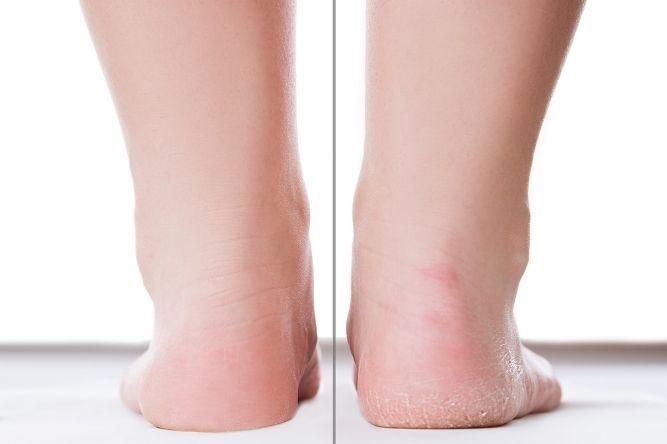Why Are My Feet Peeling?
posted: May 13, 2022.

Feet go through a significant amount of stress whenever you’re on them. That’s normal. However, when your feet start to peel, it can be a sign that something serious is at play. Peeling skin can be caused by a wide variety of common factors, such as changes in weather. In other cases, your skin peeling may be due to a foot or skin problem.
Peeling skin on the feet can be a frustrating and annoying thing to deal with. Are you curious about what could be the cause and what your treatment options are? Below, we’ll be going over the common causes of peeling and what treatment methods you can use to stop it:
Common Causes of Peeling Feet
Dry Skin
Dry skin often appears scaly, rough, and itchy, which can lead to your skin peeling. However, there are many reasons why you could be experiencing dry skin. You can cause the skin on your feet to dry out or get worse from the following:
Hot baths or showers
Dehydration
Low humidity
Too much exposure to the sun
Smoking
While peeling feet can be painful to deal with, there are multiple ways to treat and prevent them from getting worse.
Cutting down on hot baths or showers, opting for lukewarm water, and using a mild soap will help prevent the dryness or cracked skin from developing. You can apply a fragrance-free moisturizer while your feet are still wet to keep your feet hydrated. Exfoliate your feet once a week by soaking them and using a pumice stone to gently remove any dead skin.
Eczema
Eczema, also known as atopic dermatitis, is a skin condition that can occur anywhere on the body, specifically the arms, elbows, knees, scalp, and feet. When experiencing eczema, you will notice symptoms such as:
Red patches
Dry, itchy skin
Itchy rash
Cracked skin
Skin infections
Skin peeling
Eczema is often caused by genetics, environmental factors, such as allergens, or using harsh soaps. The eczema patches on your feet can result in peeling skin. There are treatment options that can reduce the severity of the eczema patches on your skin. Moisturizing daily with creams, such as a corticosteroid ointment, can control the itching and repair your dry, cracked skin. If ointments and moisturizers aren’t cutting it, an appointment with a Foot Specialist or Dermatologist may help.
Psoriasis
Psoriasis is a skin condition that causes scaly red patches to form on the skin. These patches can become painful, itchy, or begin to peel. Psoriasis commonly appears on the soles of the feet. While psoriasis and eczema may seem similar, they are both different conditions. Psoriasis is a chronic auto-immune disease, unlike eczema, which is impacted by environmental factors.
Psoriasis patches can be difficult to treat, but there are options to help soothe the inflamed skin on your feet. Treatment options include:
Topical corticosteroid creams/ointments to reduce the patches of scaly skin
Moisturizers to cut down on the dryness
Creams with salicylic acid
Athlete’s Foot
Athlete’s foot is a contagious fungal infection that mainly affects your feet. In most cases, athlete’s foot can be contracted from public locker rooms, communal showers, swimming pools, or any moist areas where you might walk barefoot. Wearing damp socks or shoes is another way that helps athlete’s foot thrive.
Common symptoms involved with Athlete’s foot involve:
An itchy red rash
A burning sensation
Stinging
Peeling skin
Blisters
Dry skin
This skin condition spawns from making contact with contaminated surfaces and has the ability to spread to other parts of your body. If you come into contact with someone else who has athlete’s foot, you may be susceptible to contracting it.
Treatment and prevention methods can rid and prevent the risk of getting athlete’s foot, such as:
Over-the-counter antifungal medication
Keeping your feet dry
Wearing footwear in public places, like locker rooms and pools
Alternating footwear and changing your socks regularly
Avoid sharing towels, shoes, or socks with other people
Tips
It’s important to practice proper foot care, especially if you’re dealing with peeling feet. These health tips include the following:
Daily moisturizing with high-quality moisturizers
Exfoliate your feet at least once a week with a pumice stone to remove dead skin
Soak your feet once a month to keep your skin healthy and clean
Start wearing shoes that are made with breathable materials
Seek treatment from a professional foot care specialist
You shouldn’t have to struggle with peeling feet. Not only can it be a painful experience, but it can also be annoying. Luckily, your foot troubles can be taken care of at our trustworthy Toronto foot clinic. We have many services and products available to relieve any foot pain you may be dealing with. Make an appointment with one of our Chiropodists today and take the first steps toward better foot care.